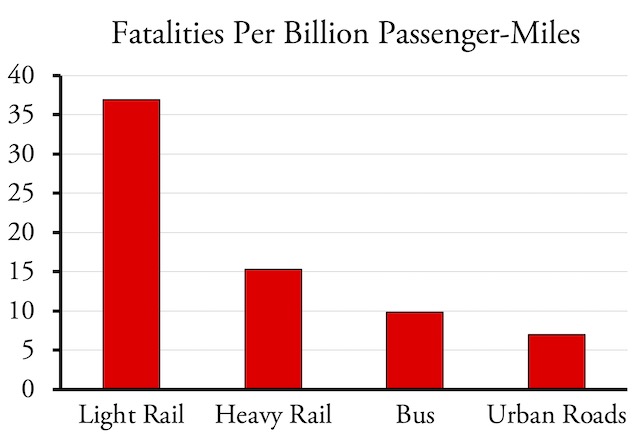Urban transit killed more people in 2022 than any year in recent history, according to data released last week by the Bureau of Transportation Statistics. The numbers show that 340 people were killed in 2022, up from 268 in 2019 and 237 in 1990. No data are available from before 1990, but it is likely that transit fatalities were less than 300 per year going back to at least 1960.
This figure shows 2022 transit fatality rates and the urban road fatality rate for 2021, as 2022 data aren’t yet available.
This rise in fatalities is particularly concerning considering that transit agencies operated only about 86 percent as many vehicle-miles of service in 2022 than they did in 2019. Despite a 14 percent reduction in service, fatalities rose by 27 percent.
A total of 340 fatalities may not sound like much compared with the 40,000 or so people killed each year on highways. But transit carries so few people that fatality rates for some modes of transit are much higher than urban highway fatality rates.
The most dangerous mode of transit by far is light rail, which killed 37 people for every billion passenger-miles it carried in 2022, up from 17 in 2019. Heavy rail fatality rates grew from 7 in 2019 to 15 in 2022 and bus rates grew from 5 to 10. Urban fatality rates aren’t yet available for 2022, but the National Highway Traffic Safety Administration reported 25,598 fatalities in 2021 on urban roads that carried about 3.67 trillion passenger-miles of travel, for a rate of 7 fatalities per billion passenger-miles. This makes urban driving in general safer than almost any kind of transit, though buses were safer before the pandemic.
(Note that these numbers are per billion passenger-miles, while the rates expressed in yesterday’s post were per billion vehicle-miles. Counting all vehicles, the Federal Highway Administration estimates about 1.7 passengers per vehicle.)
Increasing highway fatality rates are a major concern, especially as the increases coincide with the adoption of overly simplistic vision zero policies that don’t really address safety issues. But transportation planners must also be aware that urban transit can be much more dangerous than urban driving.









Increasing highway fatality rates are a major concern, especially…..”
Especially considering auto deaths kill 100x more people!
What few people die on transit isndue catastrophic rare accident or events.
Those 40,000 deaths by cars
… meh just a statistic….. those deaths are largely preventable.
US road death are way higher than Europe. We drive way more. According to Bloomberg, in 2010, Americans used their car for 85% of their daily trips, compared to 65% for Europeans. The difference was especially stark for the 30% of trips that were shorter than one mile: almost 70% of Americans used their car, while 70% of Europeans walked, biked, or took public transport.
Europe’s answer was taking terrible drivers off roads. Drivers exams are more difficult to pass. Licenses can be revoked/suspended for months or years from single DUI.
The US is car centric and result is in order to get around terrible drivers have free reign to drive. In europe , Low urban speed limits (which more survivable), pedestrian zones and barriers that separate cars from bicycles and oncoming traffic.
Solution to US traffic deaths is easy.
– Lower urban speed limits
– restrict youth driving at night except where needed
– integrate, Not segregate cycling/pedestrian use of roads.
– suspend worst drivers from the road
More importantly make driving skill tests more difficult. In order to apply for a driving license in Germany, it is necessary to show proof of an eye exam as well as a first aid course consisting of 9 units of each 45 minutes.
https://www.inc.com/justin-bariso/why-getting-a-german-drivers-license-was-one-of-the-hardest-things-ive-ever-done.html
“Lower urban speed limits”
Doesn’t work. What’s needed is lower speeds. The first does not beget the second.
Speed limits are almost universally disregarded.
Americans won’t tolerate the cost of the level of enforcement that would be required to make it work, i. e., a cop on every corner.